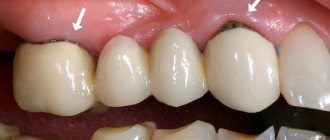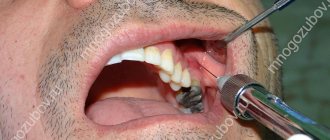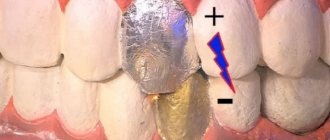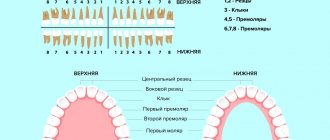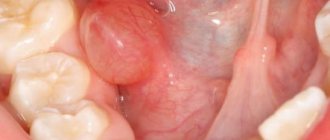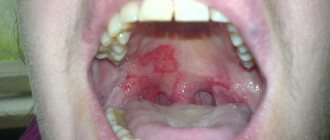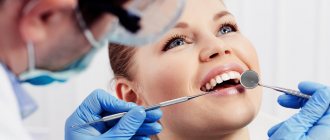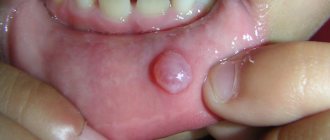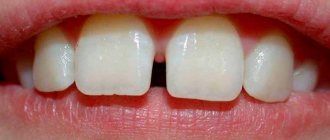Author of the article:
Soldatova Lyudmila Nikolaevna
Candidate of Medical Sciences, Professor of the Department of Clinical Dentistry of the St. Petersburg Medical and Social Institute, Chief Physician of the Alfa-Dent Dental Clinic, St. Petersburg
Today everyone knows the importance of healthy intestinal microflora, however, not every one of us thinks about the impact of oral microflora on the health of teeth, gums and the entire body as a whole. Let's talk about how, if necessary, probiotics can help restore the microflora of the oral cavity.
Microflora of the oral cavity
The human oral cavity is a unique ecological system. The permanent microflora in the mouth is formed by hundreds of different organisms; a moist, relatively warm environment creates favorable conditions for their reproduction.
The following play a significant role in the composition of the normal microflora of the oral cavity:
- veillonella, which neutralize acidic foods;
- bacteria of the genera Propionibacterium, Corynebacterium and Eubacterium, producing molecular oxygen;
- lactobacilli;
- rod-shaped lactobacilli - producers of lactic acid;
- bifidobacteria, necessary for the fermentation of carbohydrates and the production of B vitamins and others.
It is difficult to overestimate the importance of healthy oral microflora for the body. It is in this environment that the primary process of food digestion occurs, and therefore the absorption of vitamins and nutrients. Normal microflora is necessary for the proper functioning of the immune system and protecting the body from various fungal, bacterial and viral infections.
With the uncontrolled proliferation of opportunistic microflora and an imbalance of bacteria in the oral mucosa, oral dysbiosis occurs, an extremely unpleasant disease that provokes damage to tooth enamel and gums and can lead to extremely serious consequences for the entire body.
Composition of microflora in the mouth
The most common inhabitants of the oral cavity are bacteria. There are more than 500 strains. In addition, the mucous membranes are inhabited by protozoa, fungi and viruses. The number and composition of microflora organisms is individual for each person. All inhabitants of the oral cavity can be divided into 2 groups:
- Obligate or permanent environment . These bacteria are constantly present in the human mouth. The most common are lactobacilli, streptococci, staphylococci, prevotella, and bacteroides.
- Facultative or non-permanent microflora . Its penetration occurs when eating food, migration of organisms from the nasopharynx, intestines, and skin. Typical representatives of this group are pseudomonads, Escherichia coli, and Klebsiella.
How do you know when it’s time to restore the microflora?
Untimely treatment of dysbiosis can lead to tooth loss. Therefore, at the slightest sign of disease, it is important to consult a dentist as soon as possible. Based on an examination of the oral cavity and test results, the doctor will prescribe effective treatment for the pathology and, if necessary, recommend probiotics and lactobacilli for the oral cavity.
Dentists divide dysbiosis into several stages:
- Dysbiotic shift is a mild increase in the number of one of the types of opportunistic microorganisms. The general composition of the microflora does not change.
- Subcompensated dysbacteriosis. The number of beneficial microorganisms decreases slightly against the background of increased activity of opportunistic bacteria.
- Monoculture, in which beneficial microorganisms are replaced by a pathogenic monoculture, and lactobacilli in the oral cavity are absent or remain in the form of traces.
- Decompensated, in which the microflora is populated by associations of pathogenic bacteria, as well as yeast-like fungi.
At the initial stage, dysbiosis manifests itself in the form of sticking in the corners of the mouth and an unpleasant odor. At later stages of development, the disease manifests itself with symptoms such as:
- dry mouth;
- coating on the tongue;
- tartar;
- unpleasant taste in the mouth;
- point inflammation on the gums;
- bad breath;
- compaction and blisters on the mucous membrane;
- regular inflammation of the tonsils.
Mouth swab for gonococcus
The most common infection that occurs during oral sex is gonococcal pharyngitis. It develops in women.
But men who provide oral sex to their partners can also catch this infection. In this case, their disease manifests itself as gonococcal stomatitis.
Gonorrhea in the mouth is most common in homosexual men - up to 25% of all cases of infection with this pathology.
In second place are heterosexual women – 10% of cases.
Heterosexual men are least likely to become infected in this way – an average of 5%.
Most cases of oral gonorrhea are asymptomatic. That is, the patient does not complain about anything. And the only way to detect an infection is by taking a swab from the mouth. Only 15% of patients complain of sore throat. 5% of patients develop purulent tonsillitis.
Read also Urologist: tests
To identify the disease, you can take a smear and examine it microscopically. However, this method is not always effective. In the absence of signs of inflammation, there may be very few gonococci in the biomaterial. Therefore, the doctor may not notice them.
In addition, many other microorganisms live in the mouth. Some of them are similar to gonococci, although they are saprophytes. That is, harmless microorganisms that feed on food debris in the mouth and do not cause inflammatory reactions.
The doctor may confuse the bacteria, since the results are assessed visually. This limits the specificity of the study.
False positive results are possible. Therefore, more accurate diagnosis using PCR is often used. A culture may also be performed.
Oral probiotics (oral probiotics)
Probiotics are live microorganisms that promote the growth of friendly microbiota. Most often, such substances are used to improve intestinal microflora, but not many people know that there are probiotics for the oral cavity.
It is important to understand that probiotics for the oral cavity are represented by one group of substances, and probiotics for the intestines are a completely different one. Scientific research regarding these drugs is very controversial, so dentists recommend using them only as an addition to the prescribed treatment for dysbiosis.
How do probiotics work?
Dysbacteriosis and inflammatory processes in the oral cavity very often cause not only local discomfort, but also discomfort in the gastrointestinal tract and bad breath. Antibiotics, along with pathogenic microorganisms, begin to destroy the beneficial bacteria necessary for humans.
Probiotics are live strains of “friendly” bacteria and bring invaluable benefits to the body:
- help destroy pathogenic microorganisms;
- promote the regeneration of damaged tissues;
- activate the immune system;
- normalize cell metabolism;
- prevent cells from degenerating into malignant formations;
- restore the balance of fluid and beneficial microorganisms;
- prevent allergies;
- removes unpleasant odors from the mouth;
- eliminate toxins produced by pathogenic microorganisms.
Types of Oral Probiotics
Biologists call the most common types of probiotics:
- Lactobacillus and Bifidobacterium (Lactobacillus and bifidobacteria), obtained mainly from dairy products. However, it is important to normalize the population of these bacteria, but not to “overdo it” with them, since their excessive quantity provokes the formation of caries.
- Bacterial strains Bacillus subtilis, L. salivarius WB21, L. casei Shirota, L. brevis, L. reuteri, L. acidophilus may be useful in the treatment of periodontal diseases.
- Candidiasis, the most common cause of oral dysbiosis, can be treated with L. rhamnosus strains (GG and LC705) as well as Propionibacterium freudenreichii ssp. shermanii JS. This type of oral probiotic can be obtained from cheese or other fortified dairy products.
- To treat halitosis (bad breath), probiotics E. coli Nisle 1917 and S. salivarius K12 can be used.
Culture a mouth swab for gonococcus
An alternative to PCR is bacteriological culture. The material taken from the mouth is placed in a nutrient medium. Within a few days, colonies grow on it.
After this, the specialist identifies microorganisms based on properties that are unique to a specific species. It determines whether it is gonococcus or another infection.
If gonococci are detected, susceptibility to antibiotics is determined. During the procedure, various drugs are added to the nutrient medium and the reaction of bacterial colonies to them is assessed. Drugs that have shown the best sensitivity of gonococci to them will subsequently be used to treat the disease.
Treatment of dysbiosis
Remember, a disorder of the oral microflora is a complex, multifaceted and very individual disease that cannot be cured solely with probiotics. Such substances are used only as adjuvant therapy.
Dysbacteriosis should be treated only by a dentist based on smears from the mucous membrane. Therapy should be selected taking into account the general condition of the body and associated pathologies.
As a rule, the treatment of dysbiosis involves a whole range of measures and includes:
- rinsing the mouth with disinfectant solutions;
- use of special medicated toothpastes;
- the use of drugs aimed at restoring normal microflora with bifidobacteria and lactobacilli;
- taking lozenges, tablets and lozenges to eliminate pathogenic microorganisms and simultaneously restore normal microflora;
- changing the diet - including vitamin supplements in order to activate the body’s protective properties;
- taking immunomodulatory drugs to stop the development of pathogenic microflora and increase immunity;
In rare cases, with dysbiosis, dentists may prescribe antibiotics.
An assistant in restoring the microflora of the oral cavity is the probiotic complex ASEPTA PARODONTAL. This is an excellent source of lactobacilli for restoring the microflora of the oral cavity - it not only normalizes the bacterial microflora in the mouth, but also prevents the formation of biofilms of pathogenic microorganisms, reducing the formation of dental plaque - one of the factors in the occurrence of periodontal inflammation and caries.
So now you know a lot about probiotics and oral lactobacilli. We hope that you will not need treatment with such supplements, and the state of your microflora will always be excellent.
Scraping for herpes type 2 from the mouth
Herpes virus types 1 or 2 can be transmitted sexually. Most often, type 1 affects the oropharynx. And type 2 causes symptoms of inflammation of the genitourinary system and genital skin.
But due to the increasing prevalence of oral sex, often type 1 causes genital manifestations of herpes, and type 2 - oral. It is estimated that 20-25 years ago, only 10% of oral herpes cases were caused by type 2 virus. Today its share has grown to 20-30%.
The entry gate for the virus can be the mucous membrane of the lips, oral cavity, and nasopharynx. The disease is transmitted through any type of contact. It can also spread through kissing.
An infectious person is only in the stage of active infection. That is, when there are rashes on the lips or in the mouth.
A mouth swab is used to confirm the diagnosis. It allows you to establish the fact of infection and determine the type of virus.
The resulting material is examined by PCR. It detects viral DNA, which makes it possible to identify the pathogen with an accuracy close to 100%.
Read also PCR urine
Clinical researches
Conducted in the 10th Department of Dentistry and Maxillofacial Surgery of the Faculty of Dentistry of the International University of Catalonia, they proved that the use of lactobacilli helps to reduce pain and difficulty eating after tooth extraction in adult patients.
Sources:
- The use of new anti-inflammatory drugs in the complex of therapeutic and preventive measures for periodontal diseases (E.D. Kuchumova, A.A. Leontyev, O.V. Kalinina, L.Yu. Orekhova, S.B. Ulitovsky) E.D. Kuchumova, Ph.D., Associate Professor, A.A. Leontyev, dentist, O.V. Kalinina, dentist, L.Yu. Orekhova, Doctor of Medical Sciences, Professor, Head of Department, S.B. Ulitovsky, Doctor of Medical Sciences, Prof. Department of Therapeutic Dentistry of St. Petersburg State Medical University named after. acad. I.P. Pavlova
- The use of drugs from the Asepta line in the complex treatment of inflammatory periodontal diseases (N.V. Berezina E.N. Silantyeva S.M. Krivonos, Kazan State Medical Academy. Kazan.) N.V. BEREZINA, E.N. SILANTIEVA, S.M. KRIVONOS Kazan State Medical Academy
- Clinical experience in using the Asepta series of products Fuchs Elena Ivanovna Assistant of the Department of Therapeutic and Pediatric Dentistry State Budgetary Educational Institution of Higher Professional Education Ryazan State Medical University named after Academician I.P. Pavlova of the Ministry of Health and Social Development of the Russian Federation (GBOU VPO RyazSMU Ministry of Health and Social Development of Russia)
Consumer Reviews
Christina (vseotzyvy.ru)
“I had such a delicate problem as bad breath. I was checked by a gastroenterologist - everything was fine with my stomach, so the doctor sent me to a dentist colleague. Everything also seems to be normal, but the smell doesn’t go away. The doctor suggested that my microflora was not all right and advised me to take the Asept probiotic complex. These are tablets with active probiotics and vitamin D, which restore oral microflora and kill germs and harmful bacteria. In fact, after the Asepta course, my mouth stopped smelling bad, and now I’m not afraid to talk to people).”
Vera (vseotzyvy.ru)
“I was tormented by stomatitis. I’ll just treat the slightest hypothermia, and I’ll be healthy again. The dentist said that probably the cause of the problems should be looked for inside and advised me to drink a complex of probiotic microorganisms from Asepta to support the immune system. These “vitamins” normalize the composition of the bacterial flora of the oral cavity, enhance the ability of the mucous membrane to resist bacteria and infections, contain active probiotics, lactobacilli and vitamin D, which promotes the absorption of calcium. I bought a package of Asepta, the design, by the way, is interesting and calm. Now every evening after brushing my teeth I take one tablet and dissolve it. The course of treatment is one month. Stomatitis has not made itself felt all this time.”
